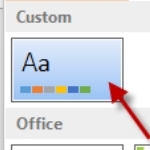
By Ellen Finkelstein
Here’s a common scenario.
You have a table of Excel data and you need to discuss it in detail at a meeting. But there’s no way it will fit on one slide. What are your options?
1. You could print out the data so people can see it up close. I recommend doing this when necessary.
2. You could split the data onto 2 slides and use a dynamic transition between them. Dynamic transitions are new for PowerPoint 2010.
What’s a dynamic transition?
A dynamic transition has two special features:
1. The transition applies to your slide content, but not the background. This makes your content seem to move independently from the background.
2. The transition works backward when you move to the previous slide.
You don’t need to add the transition to the first slide of a set.
I recommend using transitions very sparingly. When a presentation has a transition applied to all slides, I find it distracting. Don’t you? You want your audience to focus on the content, not the special effects!
But occasionally, a transition can actually help your audience understand what you are saying. When you need to span data over 2 or more slides, the Pan dynamic transition can help.
Here are two slides that provide historical data on health expenditures in the United States. In many cases, a chart (graph) would work better, but let’s say that your audience wants to analyze the specific numbers, so you need to use a table. You can see that this data wouldn’t fit on 1 slide, because it covers a span of 20 years!

Article continued here
This excerpt is shared with permission from ellenfinkelstein.com.




